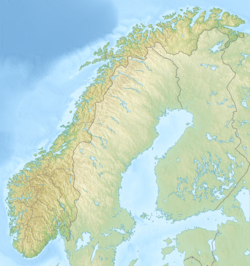Tyssedal Power Station
| Tyssedal Hydroelectric Power Station | |
|---|---|
 |
|
| Official name | Tyssedal kraftverk |
| Country | Norway |
| Location | Tyssedal |
| Coordinates | 60°07′17″N 6°33′20″E / 60.12139°N 6.55556°ECoordinates: 60°07′17″N 6°33′20″E / 60.12139°N 6.55556°E |
| Status | Museum |
| Commission date | 1906 |
| Decommission date | 1989 |
| Owner(s) | Tyssefaldene (-1989) |
| Pumped-storage power station | |
| Upper res. capacity | 426×106 m3 (0.426 km3) |
| 5 | |
| Hydraulic head | 400 m |
| Power generation | |
| Make and model | Pelton wheel |
| Units decommissioned | 15 |
| Nameplate capacity | 100 MW |
| Capacity factor | 80.0% |
| Annual output | 700 GW·h |
The Tyssedal Power Station is a hydroelectric power station and museum located in Tyssedal in the municipality Odda in Hordaland, Norway. The station was designed by architect Thorvald Astrup. It started production in 1906 and operated at a combined installed capacity of 100 MW from 1918, with an average annual production of 700 GWh. The plant was protected by the Norwegian Directorate for Cultural Heritage in 2000, and is part of the Norwegian Museum of Hydropower and Industry.
It is an anchor point of the European Route of Industrial Heritage (ERIH).
...
Wikipedia

